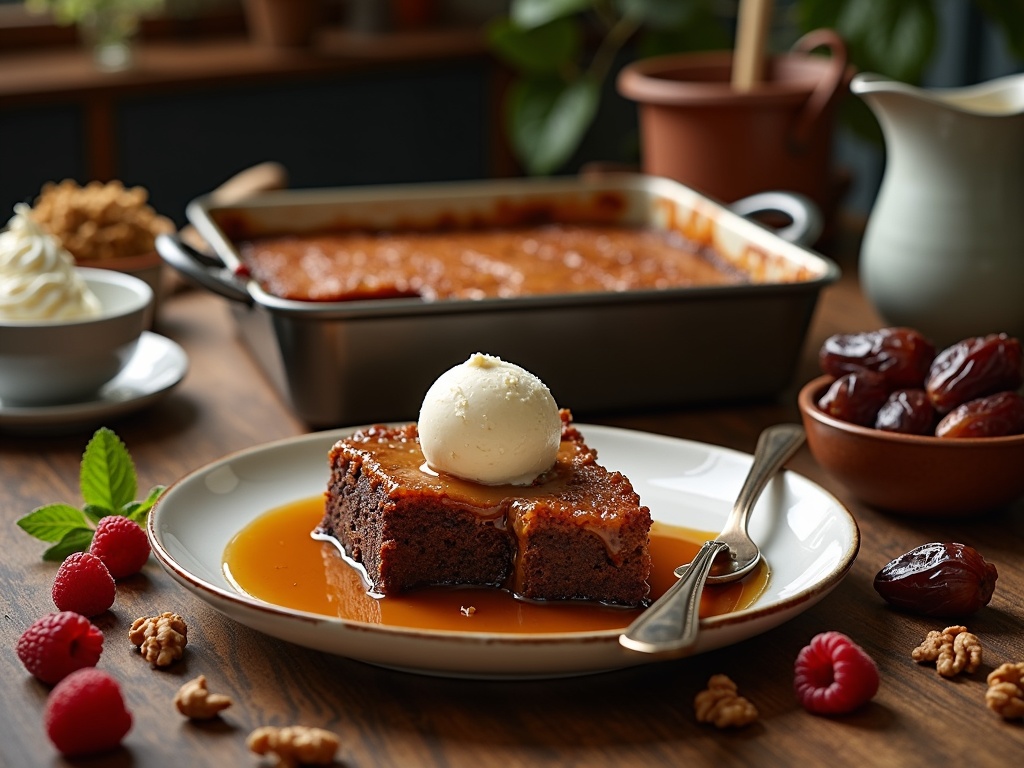Sticky toffee pudding recipe stands as a treasured British dessert that pairs an incredibly moist date sponge cake with a decadent, buttery toffee sauce, creating the ultimate comfort food.
Though its mid-20th century origins spark debate, this iconic dessert has captured hearts worldwide with its perfect balance of textures and deep caramel flavors, making it ideal for special occasions.
Table of Contents
Key Takeaways
- The secret to sticky toffee pudding’s exceptional texture lies in the dates, which create natural moisture and caramel-like sweetness when properly soaked and incorporated
- The warm butterscotch toffee sauce transforms the dessert, ideally served warm with cold ice cream or cream for a delightful temperature contrast
- Room temperature ingredients and precise measurements are crucial for creating the perfect pudding texture
- The pudding can be made ahead and actually improves with time as flavors deepen, making it an excellent make-ahead dessert option
- Proper storage techniques allow for enjoyment up to 5 days refrigerated or 3 months frozen, with several effective reheating methods available
Why Dates Are the Star Ingredient
I find that dates truly work magic in this recipe. They dissolve into the batter, leaving behind their natural sweetness while adding incredible moisture. After making this dessert countless times, I’ve learned that properly soaking the dates makes all the difference in achieving that signature soft, tender crumb that sticky toffee pudding fans crave.
The Importance of the Toffee Sauce
The toffee sauce deserves special attention. It’s not just a topping but a transformative element that soaks partially into the warm cake. I always serve the pudding warm with a cold scoop of vanilla ice cream. This temperature contrast elevates the dessert from good to extraordinary.
Expert Tips for the Perfect Result
For best results, I bring all ingredients to room temperature before starting. This simple step ensures even baking and proper incorporation. Precise measurements matter too—sticky toffee pudding demands accuracy for its signature texture.
Make Ahead and Storage Options
One of the benefits of this classic dessert? It actually tastes better the next day. I often bake it in advance, allowing the flavors to mature and deepen. The pudding stores beautifully in the refrigerator for up to five days or freezes for three months without losing quality. When ready to serve, I gently reheat it to bring back that fresh-baked warmth.
The Ultimate Comfort Dessert
Sticky toffee pudding sits at the top of my comfort food list—a gloriously moist date sponge cake drenched in rich toffee sauce. This iconic British dessert has earned its reputation as one of the most satisfying sweet treats you can make at home.
A British Classic with Rich History
This dessert emerged on the British culinary scene in the mid-20th century, though its exact origins are debated. Some credit the Sharrow Bay Hotel in England’s Lake District, while others suggest it came from elsewhere in the country. Regardless of its birthplace, sticky toffee pudding has become a staple on dessert menus throughout the UK and has gained fans worldwide.
Making this dessert isn’t as complicated as you might think. The entire process takes about an hour from start to finish:
- Preparation: 20 minutes for measuring, chopping dates, and mixing
- Baking: 30-35 minutes for the sponge
- Final touches: 5-10 minutes for the toffee sauce
In terms of difficulty, I’d rate this as a moderate baking project. Even if you’ve just started your baking journey, you can handle this with careful attention to the recipe. The date sponge requires basic mixing techniques, while the toffee sauce needs a bit of focus to achieve that perfect consistency.
What makes sticky toffee pudding so special is its wonderful contrast of textures—the incredibly soft, moist cake against the smooth, buttery toffee sauce. The dates give the sponge a natural sweetness and that characteristic dark color without an overwhelming date flavor. It’s the perfect finish to a hearty weekend breakfast or special dinner.
For a complete dessert experience, I always serve it warm with a scoop of vanilla ice cream or a dollop of freshly whipped cream. The heat from the pudding melts the ice cream slightly, creating an irresistible hot-cold combination that’s hard to beat. For a simpler but equally delicious pudding option, you might also enjoy making a simple chia pudding when you’re short on time.
With its deep caramel flavors and comforting warmth, sticky toffee pudding has earned its place as a dessert that brings people together—perfect for Sunday lunches, holiday gatherings, or anytime you need a sweet pick-me-up.
What Makes This Pudding Special
Sticky toffee pudding stands out in the dessert world for its unique combination of moisture, sweetness, and warm, comforting flavors. I’ve found that this classic British treat has gained worldwide popularity because it delivers something that few other desserts can match — pure, indulgent comfort that satisfies on the deepest level.
The Magic of Dates
The secret to this pudding’s exceptional texture lies in its key ingredient: dates. When soaked and pureed, dates transform the cake base into something truly magical. The fruit breaks down during baking, creating:
- A naturally sweet foundation that reduces the need for excessive sugar
- An incredibly moist crumb that stays tender for days
- A deep, caramel-like undertone that complements the toffee sauce perfectly
This natural moisture from the dates means the cake never dries out, unlike many traditional sponge cakes. I can attest that even leftover slices maintain their luscious texture, making this pudding recipe unlike other desserts that quickly lose their appeal.
The Irresistible Toffee Sauce
While the date-filled sponge is delicious on its own, what truly elevates sticky toffee pudding to legendary status is the warm butterscotch toffee sauce. This glossy, amber-colored sauce is the crown jewel of the dessert, creating an experience that’s greater than the sum of its parts.
The sauce delivers a perfect balance of flavors — not cloyingly sweet but rich with caramelized notes that dance on your taste buds. The butter provides a velvety mouthfeel while brown sugar and cream create depth and complexity. When poured over the warm sponge, the sauce gets partially absorbed while leaving enough to pool around the edges, creating the ideal ratio in every bite.
I’ve discovered that serving this pudding warm is essential to experiencing its full glory. The contrast between the warm cake and sauce against a scoop of cold vanilla ice cream or a dollop of lightly whipped cream creates a temperature contrast that heightens the overall sensory experience.
This dessert hits all the right notes for special occasions. Its rich complexity makes it feel indulgent enough for celebrations while remaining accessible enough that anyone can enjoy it. The homey, nostalgic quality of sticky toffee pudding makes it particularly suited for winter gatherings when warm desserts are most appreciated.
What’s particularly special about sticky toffee pudding is its ability to please both sophisticated and simple palates. Children love its sweet, caramel notes, while adults appreciate the nuanced flavors and the fact that it’s not overly sweet like many commercial desserts.
I’ve served this at everything from casual family dinners to elegant dinner parties, and it never fails to impress. There’s something about cutting into that moist sponge and watching the sauce slowly envelop each portion that creates an anticipation few other desserts can match.
The versatility of sticky toffee pudding also adds to its special nature. It can be prepared in a large dish for family-style serving or as individual portions for a more elegant presentation. It pairs beautifully with cream-based accompaniments like custard, ice cream, or whipped cream, allowing each person to customize their serving.
Whether you’re looking to impress guests or simply want to treat yourself to something extraordinary, sticky toffee pudding delivers an experience that transcends the ordinary. Its perfect balance of flavors, textures, and temperatures creates a dessert that’s both comforting and sophisticated — truly the best of both worlds.
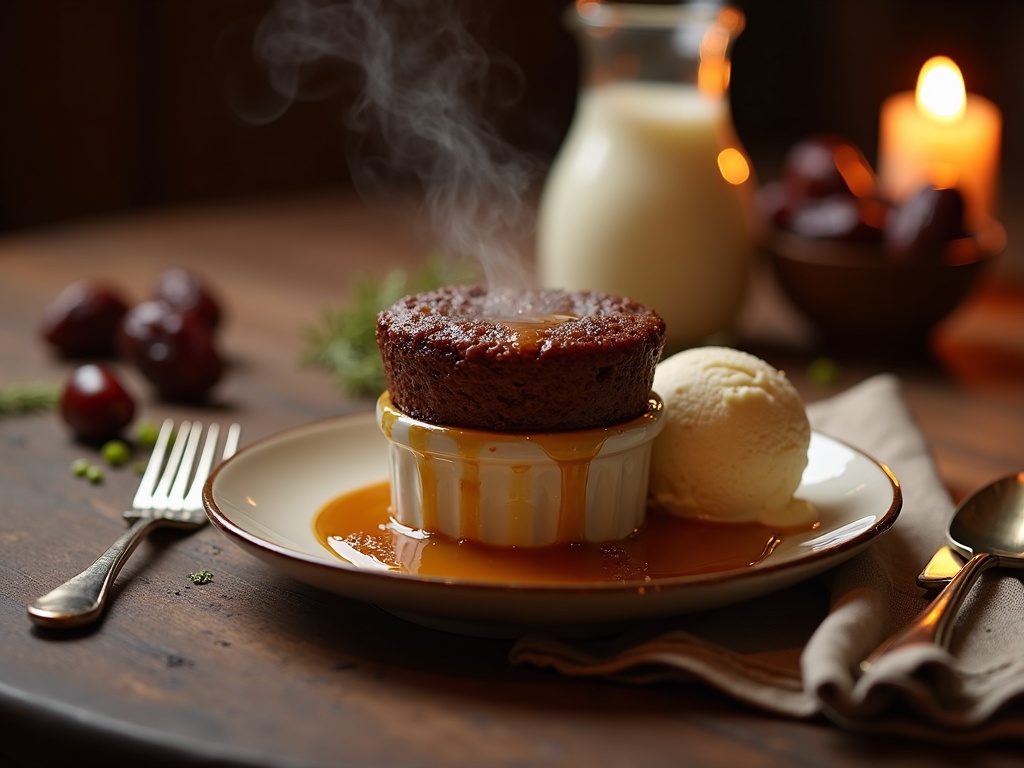
Kitchen Tools You’ll Need
Before diving into this classic British dessert, let’s set up your kitchen workspace with the right equipment. I’ve found that having everything ready makes the process much smoother.
Essential Equipment
First on my list is a 9-inch square baking pan, which provides the perfect depth and surface area for your sticky toffee pudding to bake evenly. You’ll want one with slightly raised edges to contain the rich toffee sauce that soaks into the cake.
A large mixing bowl is crucial for combining your dry ingredients and for folding in the wet components without making a mess. I prefer glass or stainless steel bowls as they don’t retain odors or stains.
For the decadent toffee sauce, a good quality saucepan is non-negotiable. A medium-sized one with a heavy bottom prevents the sugar from burning as you create that caramel goodness that’s similar to what you’d find in a creamy chia pudding but with a much richer flavor profile.
An electric mixer will save your arm muscles when creaming butter and sugar together. While you can mix by hand, an electric hand mixer or stand mixer creates that light, airy texture that makes the pudding so irresistible.
Precise measurements matter in baking, so gather your measuring cups and spoons. I recommend using separate ones for wet and dry ingredients to ensure accuracy. If you’re looking to create other desserts afterward, these tools are just as essential for making a smooth buttercream frosting or other sweet treats.
Lastly, a fine-mesh strainer helps sift the flour and other dry ingredients, removing any lumps and incorporating air for a lighter texture. This step might seem small, but it makes a noticeable difference in the final consistency of your pudding, just as it would when preparing the base for fluffy American pancakes.
With these tools ready, you’re perfectly equipped to create a sticky toffee pudding that’s moist, rich, and utterly delicious.
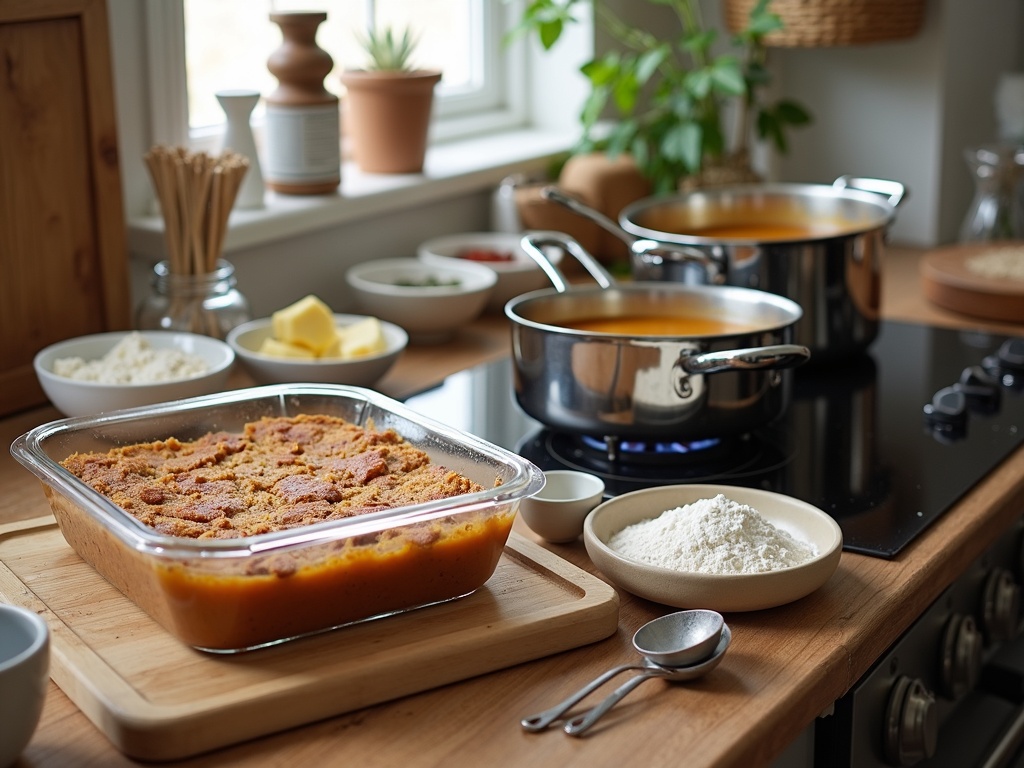
Ingredients for the Cake
The foundation of any great sticky toffee pudding starts with quality ingredients. I’ve perfected this recipe over years of testing, finding the perfect balance of sweetness and moisture that makes this dessert a true standout at any dinner table.
Core Ingredients
Dates form the heart and soul of sticky toffee pudding. I recommend using 200g (about 1½ cups) of pitted and finely chopped Medjool dates for their natural caramel-like sweetness. Dates aren’t just sweet — they provide moisture that gives the cake its signature dense yet soft texture.
You’ll need to soften these dates in 240ml (1 cup) of hot water mixed with 1 teaspoon of baking soda. This crucial step breaks down the dates, allowing their flavor to permeate throughout the cake. The baking soda also helps neutralize the acidity while creating a more tender crumb structure in the final product.
For the dry ingredients, gather:
- 175g (1½ cups) all-purpose flour
- 1 teaspoon baking powder
- ¼ teaspoon salt
These measurements create the perfect structure for the cake, allowing it to rise properly while maintaining that characteristic pudding texture that pairs so beautifully with rich dessert toppings.
Wet Ingredients and Flavorings
The depth of flavor in sticky toffee pudding comes from carefully selected wet ingredients that complement the dates. I’ve found that 85g (6 tablespoons) of softened unsalted butter creates the right level of richness without overwhelming the other flavors.
Dark brown sugar is non-negotiable here — you’ll need 150g (¾ cup) to achieve that deep molasses note that makes the pudding so distinctive. Light brown sugar simply doesn’t provide the same complexity as its darker counterpart.
Two large eggs provide structure and binding, while 1 teaspoon of vanilla extract rounds out the flavor profile with its warming aromatic qualities. The vanilla particularly enhances the caramel notes that develop during baking.
I find it helpful to bring all refrigerated ingredients to room temperature before mixing. This simple step ensures everything incorporates smoothly, preventing the lumpy batter that can lead to uneven baking. Room temperature eggs and butter blend more readily with the sugar, creating the light, airy base needed before adding the date mixture.
Many bakers overlook the importance of measuring ingredients precisely for this recipe. The balance between the flour and wet ingredients is delicate — too much flour creates a dry cake that misses the mark on the pudding-like consistency we’re aiming for. I recommend using a kitchen scale for accuracy, especially for the flour and brown sugar.
The quality of vanilla makes a noticeable difference in the final flavor. Pure vanilla extract delivers a cleaner, more authentic flavor than artificial varieties. If you’re feeling adventurous, you might even try using vanilla bean paste for tiny flecks of vanilla throughout the cake.
While not traditionally part of a classic pudding recipe, a pinch of cinnamon or nutmeg can add a subtle warmth to the cake. This optional addition works particularly well when serving the pudding during colder months.
Once you’ve gathered all ingredients, you’ll be ready to create this beloved British dessert that’s gained international fame for good reason. The combination of these simple ingredients transforms into something truly magical during the baking process, especially when topped with the toffee sauce we’ll explore next.
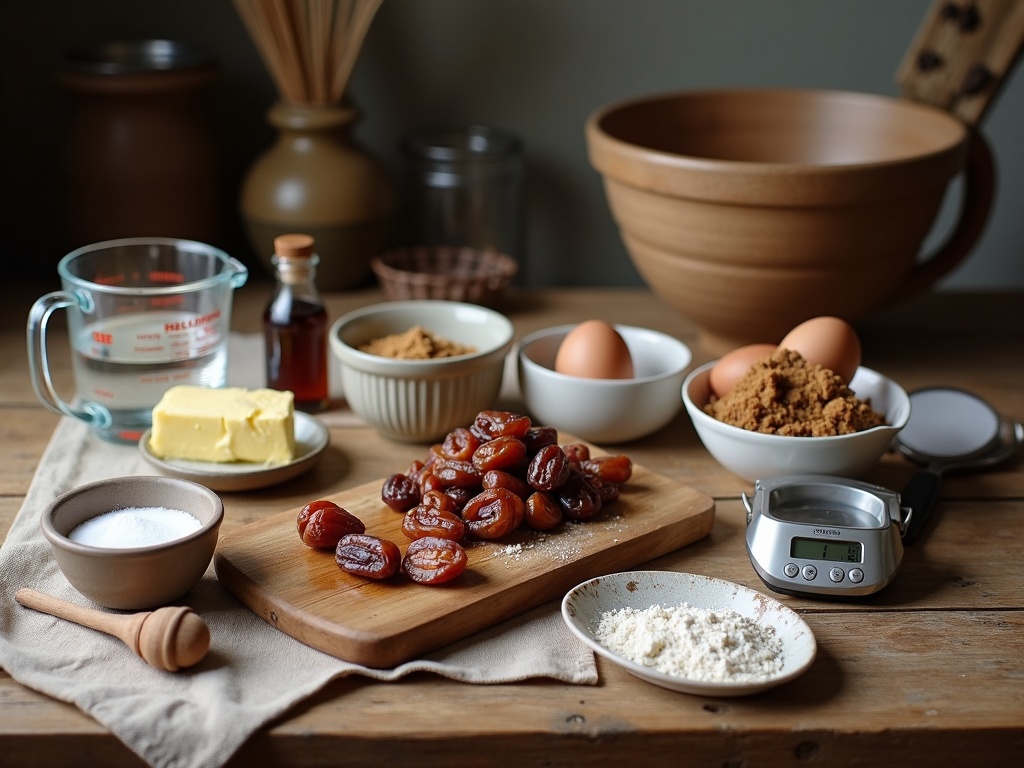
Toffee Sauce Components
The toffee sauce is arguably the crowning glory of any sticky toffee pudding. It’s what truly sets this dessert apart, transforming a simple sponge into a decadent treat that’s impossible to resist. I’ve found that mastering this sauce elevates the entire dessert to new heights, turning a homemade pudding into a restaurant-quality experience.
Essential Ingredients
Heavy cream serves as the luxurious base for any good toffee sauce. It provides that silky-smooth texture that allows the sauce to coat each bite of pudding perfectly. The fat content in heavy cream (sometimes called double cream) is crucial here – don’t be tempted to substitute with lighter versions as they won’t provide the same richness or stability to your sauce.
Unsalted butter adds depth and a velvety mouthfeel that’s simply irreplaceable. I always use unsalted butter because it gives me complete control over the salt level in the final sauce. The butter also helps emulsify the sauce, creating that glossy finish that makes the pudding look as good as it tastes. When melted together with the sugar, it creates that characteristic toffee flavor that’s both complex and comforting.
Dark brown sugar is essential for developing the deep, caramel notes that define a proper toffee sauce. Unlike light brown sugar or white sugar, dark brown sugar contains more molasses, which brings a robust flavor profile with hints of toffee, caramel, and even slight coffee notes. These complex flavors pair beautifully with the rich pudding texture of the dessert.
A splash of vanilla extract might seem like a small addition, but it rounds out the flavor profile beautifully. The warm, aromatic quality of vanilla balances the sweetness and adds complexity to the sauce. I prefer using pure vanilla extract rather than artificial variants for a cleaner, more authentic taste.
A pinch of salt might be the smallest ingredient by volume, but it’s perhaps the most transformative. Salt enhances all the other flavors while creating a perfect sweet-savory balance. It cuts through the richness and prevents the sauce from being cloyingly sweet. This contrast is what makes the sauce so addictive and keeps you coming back for “just one more bite.”
Preparation Techniques
Creating the perfect toffee sauce isn’t just about having the right ingredients – technique matters just as much. The key is achieving the right consistency while developing those deep toffee flavors.
- I start by combining the butter and dark brown sugar in a heavy-bottomed saucepan over medium heat. This initial step is crucial – allowing the sugar to dissolve completely in the melted butter creates the foundation for a smooth sauce. Patience is important here; rushing can lead to grainy texture or burned sugar.
- Once the butter and sugar mixture is bubbling gently and the sugar has fully dissolved, I carefully add the heavy cream. This step requires caution as the mixture will bubble up dramatically. The cream needs to be incorporated gradually while stirring constantly to achieve that perfect silky texture that makes velvety sauce coats each bite of pudding.
- After the cream is incorporated, I add the vanilla extract and salt, then allow the sauce to simmer gently until it reaches the desired thickness. The longer you simmer, the thicker and more intense the sauce becomes. For sticky toffee pudding, I aim for a consistency that’s pourable when warm but still clings beautifully to the pudding.
The finished toffee sauce should be glossy, smooth, and rich amber in color. When poured over warm sticky toffee pudding, it creates that signature look and taste that makes this classic British dessert so beloved worldwide.
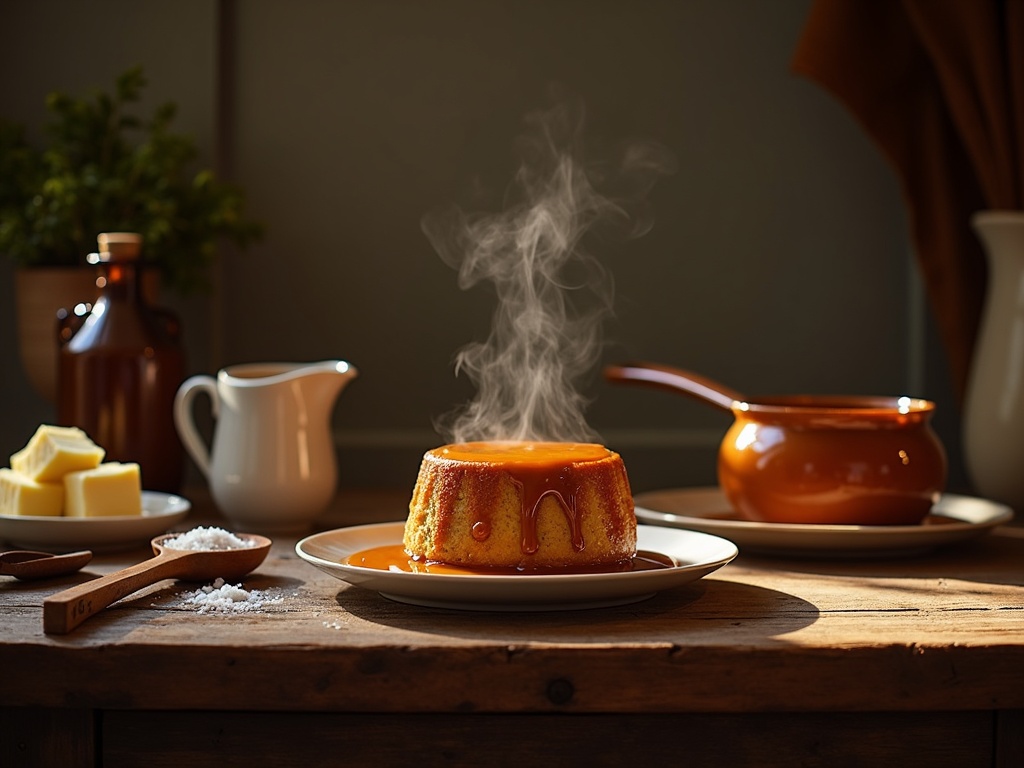
Steps to Create the Perfect Pudding
Crafting Your Sticky Toffee Masterpiece
I start by preparing the date mixture, which forms the heart of any authentic sticky toffee pudding. First, I chop 200g of pitted dates into small pieces and place them in a heatproof bowl. Then I pour over 1 cup of boiling water and add 1 teaspoon of baking soda. This mixture needs to sit for about 10 minutes until the dates soften and break down, creating that signature dark, moist texture that’s essential to a great traditional pudding recipe.
For the cake batter, I cream together 85g of softened unsalted butter with 175g of brown sugar until light and fluffy. The key is to incorporate plenty of air at this stage. Then I beat in 2 eggs, one at a time, followed by a teaspoon of vanilla extract. In a separate bowl, I sift 175g of self-raising flour with a pinch of salt, then fold it gently into the wet mixture. Finally, I stir in the cooled date mixture until just combined. Overmixing will make the pudding dense rather than deliciously light.
Baking instructions are crucial for achieving that perfect texture:
- Pour the batter into a greased 23cm square baking dish.
- Bake at 180°C (350°F) for 25–30 minutes.
- The pudding is done when it springs back when lightly pressed and a skewer inserted in the center comes out clean.
While it’s still warm, I poke small holes all over the surface using a skewer — this allows the toffee sauce to seep in.
The toffee sauce is what transforms this dessert from good to extraordinary:
- Melt 175g of brown sugar with 100g of butter in a heavy-based saucepan over low heat.
- Stir in 225ml of heavy cream and let it bubble gently for 2–3 minutes until slightly thickened.
- Add a splash of vanilla and a pinch of salt to balance the sweetness, similar to how they enhance a buttercream recipe.
For assembly, I pour half the warm toffee sauce over the hot pudding, allowing it to soak in. Before serving, I reheat the remaining sauce and pour it over individual portions. The pudding pairs wonderfully with vanilla ice cream or fresh whipped cream. For special occasions, I sometimes add a fresh fruit topping to cut through the richness.
This sticky toffee pudding can be made ahead and reheated — in fact, many say it tastes even better the next day! Just cover and refrigerate, then warm through in the oven or microwave before serving with extra sauce.
Common Mistakes to Watch For
Creating the perfect sticky toffee pudding isn’t rocket science, but there are several pitfalls that can turn this heavenly dessert into a disappointing experience. I’ve made these mistakes myself in the past, so I’ll share what I’ve learned to help you avoid them.
Preparation and Baking Errors
Using cold ingredients straight from the refrigerator is one of the most common errors when making sticky toffee pudding. Cold eggs, butter, and milk don’t incorporate well, leading to a lumpy batter and uneven texture. I always set my ingredients out at least 30 minutes before starting to ensure they reach room temperature. This simple step makes a huge difference in how your pudding turns out.
Overmixing the batter is another frequent mistake that can ruin your dessert. When you mix the batter too vigorously or for too long, you develop the gluten in the flour, resulting in a tough, rubbery pudding rather than the soft, tender texture we’re aiming for. I mix just until the ingredients are combined, then stop – a few small lumps are actually preferable to an overmixed batter.
The baking temperature can make or break your sticky toffee pudding. Many recipes call for a moderate oven (around 350°F/180°C), but if your oven runs hot or cold, your pudding might not cook properly. I recommend using an oven thermometer to verify the actual temperature. Too hot, and the outside will burn while the inside remains raw; too cool, and your pudding will dry out before it’s fully cooked.
Not soaking the dates properly is perhaps the most critical mistake. The dates need adequate time to soften and break down, as they provide both moisture and that distinctive caramel-like flavor to the homemade pudding recipe. I always soak mine in hot water or brewed tea for at least 15 minutes, then blend them into a smooth paste. Skipping this step results in a pudding lacking in both flavor and moisture.
Rushing the toffee sauce preparation can also lead to disappointment. The sauce needs time to thicken properly and develop its rich flavor. If you hurry this process, you might end up with a thin, pale sauce that lacks the deep, complex sweetness that makes sticky toffee pudding so irresistible. I simmer mine gently, giving it my full attention until it reaches that perfect amber color and coats the back of a spoon.
Other Common Mistakes
- Not greasing your baking dish thoroughly, causing the pudding to stick
- Opening the oven door too early during baking, which causes the pudding to sink
- Forgetting to poke holes in the baked pudding before pouring the sauce over
- Using low-quality dates that lack flavor and moisture
- Skimping on the sauce (the “sticky” in sticky toffee pudding comes from generous sauce)
I’ve found that patience is truly the key to a successful sticky toffee pudding. Taking your time with each step of the process ensures that your dessert recipe will turn out perfect every time. The contrast between the warm, soft cake and the rich, buttery sauce is what makes this dessert so special.
If you’re looking for other comforting desserts, you might enjoy making a delicious rhubarb crumble or a warm peach crisp using similar techniques. The skills you develop making sticky toffee pudding transfer well to other baked goods.
For a complete meal, consider serving your sticky toffee pudding after a main course of hearty breakfast pancakes or follow it with a refreshing strawberry shortcake for a dessert buffet that will impress your guests.
Expert Tips for Success
Achieving the perfect sticky toffee pudding requires attention to a few key details. I’ve gathered some expert tips that will elevate your dessert from good to extraordinary, ensuring you get that perfect balance of moist cake and rich toffee sauce every time.
Perfecting Your Preparation
Starting with room temperature ingredients makes a significant difference in your final pudding. Cold eggs or butter don’t incorporate as smoothly, potentially leaving you with a lumpy batter. I recommend taking your eggs and butter out of the refrigerator at least 30 minutes before you start baking.
When it comes to the dates, proper chopping technique matters more than you might think. Dates should be chopped into small, uniform pieces rather than large chunks. This allows them to soften properly when soaked in hot water and distribute evenly throughout the batter. For the best texture in your pudding recipe with dates, aim for pieces about the size of raisins.
Testing for doneness can be tricky with sticky toffee pudding because it’s meant to be moist. The toothpick test works differently here — when inserted into the center, it should come out with a few moist crumbs attached, not completely clean. If it comes out wet with batter, continue baking in 3-minute increments until properly set. Over-baking will result in a dry pudding, which defeats the purpose of this luscious dessert.
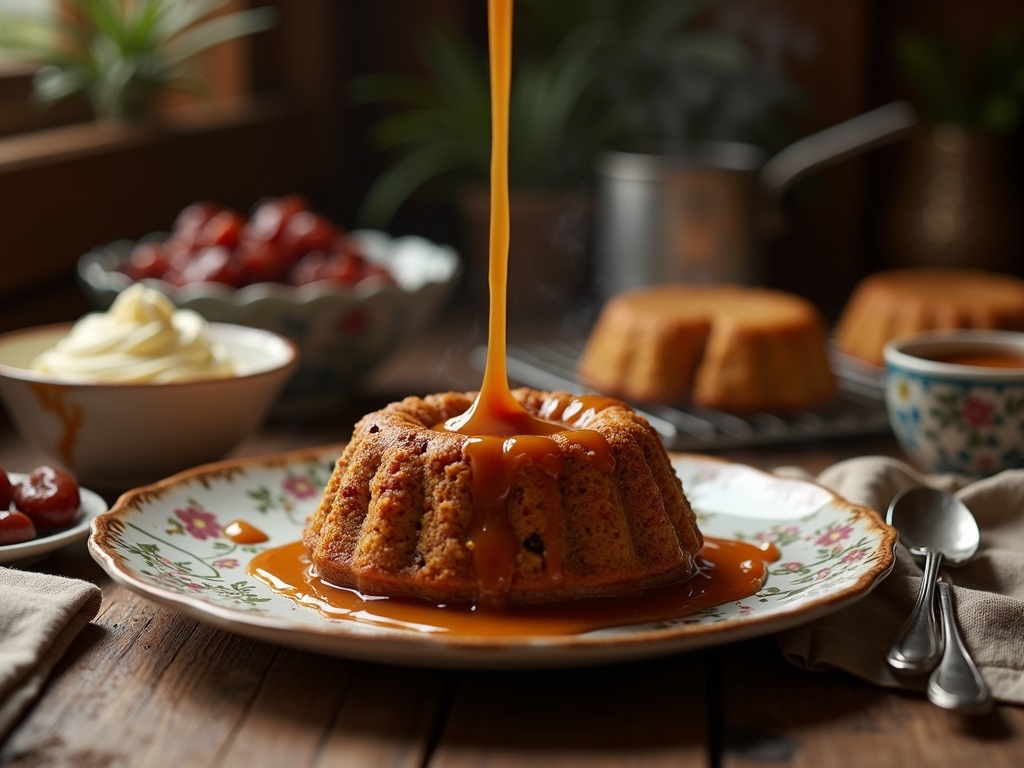
Sauce and Storage Guidance
The toffee sauce is equally important as the cake itself. For perfect consistency, the sauce should coat the back of a spoon but still pour easily. If your sauce becomes too thick after cooling, simply warm it gently with an additional tablespoon of cream. Too thin? Simmer it a bit longer to reduce and thicken.
Here are some indicators for sauce doneness:
- Light coating: Sauce runs off quickly when drizzled from a spoon
- Medium coating: Sauce forms a ribbon that holds for 1–2 seconds before merging
- Thick coating: Sauce forms a defined ribbon that holds its shape for several seconds
Storage is crucial for maintaining quality. The pudding can be made a day ahead and stored at room temperature, tightly wrapped. For longer storage, I’ve found that freezing works surprisingly well — wrap individual portions tightly in plastic wrap and then foil. The toffee sauce should be refrigerated separately in an airtight container for up to a week. When ready to serve, warm the pudding gently in the microwave and heat the sauce separately before pouring over.
For an extra special touch, consider making a light buttercream frosting to serve alongside your sticky toffee pudding for guests who enjoy contrasting flavors.
The pudding will absorb more sauce the longer it sits, which many people prefer. I often make the pudding ahead specifically for this reason — the flavors deepen and meld beautifully after a day. If you’re serving it to guests, consider making it the day before and adding fresh sauce just before serving for the perfect balance of texture and flavor.
Remember that sticky toffee pudding pairs wonderfully with other traditional desserts like rhubarb crumble for a quintessentially British dessert spread. Its rich flavor profile also complements lighter fruit-based desserts such as strawberry shortcake or peach crisp when serving a variety of sweets.
Serving Suggestions
Sticky toffee pudding is at its absolute best when served warm, allowing the rich toffee sauce to melt into the sponge for that perfect bite of heaven. I’ve found that serving this classic British dessert at around 140°F (60°C) hits the sweet spot – warm enough to highlight the caramel notes without burning your guests’ mouths.
Perfect Pairings and Presentation
This indulgent dessert deserves thoughtful accompaniments to create a complete experience. Here are some companions that elevate sticky toffee pudding to new heights:
- Vanilla ice cream: The cold creaminess against the warm, rich pudding creates an irresistible temperature contrast.
- Clotted cream: For an authentic British touch that adds luxurious richness.
- Fresh berries: Raspberries or strawberries provide a tart counterpoint to the sweetness.
- Crème fraîche: Its slight tanginess cuts through the dessert’s sweetness.
- Chopped nuts: Toasted pecans or walnuts add welcome textural contrast.
When it comes to portion sizes, I’ve found that moderation works best with this rich dessert. A 2×2-inch square or a single ramekin (about 4 oz / 115 g) per person strikes the right balance between satisfaction and overindulgence. For dinner parties, smaller portions with elegant plating allow guests to indulge without feeling overwhelmed.
Speaking of presentation, it can transform this homey dessert into something special. I like to place a warm slice on a warmed plate (crucial for keeping the dessert at the ideal temperature), then drizzle additional warm toffee sauce in an artistic pattern. A small quenelle of fresh cream or buttercream alongside provides a beautiful contrast, while a mint sprig adds a pop of color.
If you’re serving family-style, consider bringing the whole pudding to the table in its baking dish, topped with sauce and a pitcher of cream on the side – this creates a lovely communal dessert moment.
For reheating leftover pudding (if you’re lucky enough to have any!), I recommend covering individual portions with foil and warming in a 325°F (165°C) oven for 10–15 minutes. For quicker results, microwave on medium power for 30-second bursts until just warmed through. The key is avoiding overheating, which can dry out the pudding. Always warm additional toffee sauce separately, as it heats more quickly than the sponge.
When serving at a dinner party, try creating a pudding dessert station with various toppings in small bowls, allowing guests to customize their portions. This interactive approach adds fun to the dining experience.
For special occasions, I like to present individual puddings in pretty teacups or ramekins, pre-drizzled with sauce and ready to serve. This method is particularly handy when hosting, as you can prepare everything beforehand and simply reheat when needed.
During colder months, sticky toffee pudding pairs beautifully with warming beverages like coffee, tea, or even a small glass of dessert wine. The fruit notes in these accompaniments provide a pleasant counterpoint to the dessert’s rich sweetness.
Remember that sticky toffee pudding freezes exceptionally well, so don’t hesitate to make a larger batch and freeze individual portions. To enjoy later, thaw overnight in the refrigerator before reheating using the methods mentioned above.
With these serving suggestions, your sticky toffee pudding will shine as a standout dessert that guests will remember long after the meal ends.
Storage and Make-Ahead Options
Sticky toffee pudding is one of those rare desserts that stores exceptionally well and can even taste better a day after making it. I’ve found that proper storage techniques can preserve both the flavor and texture of this classic British dessert, allowing you to enjoy it well beyond the day it’s made.
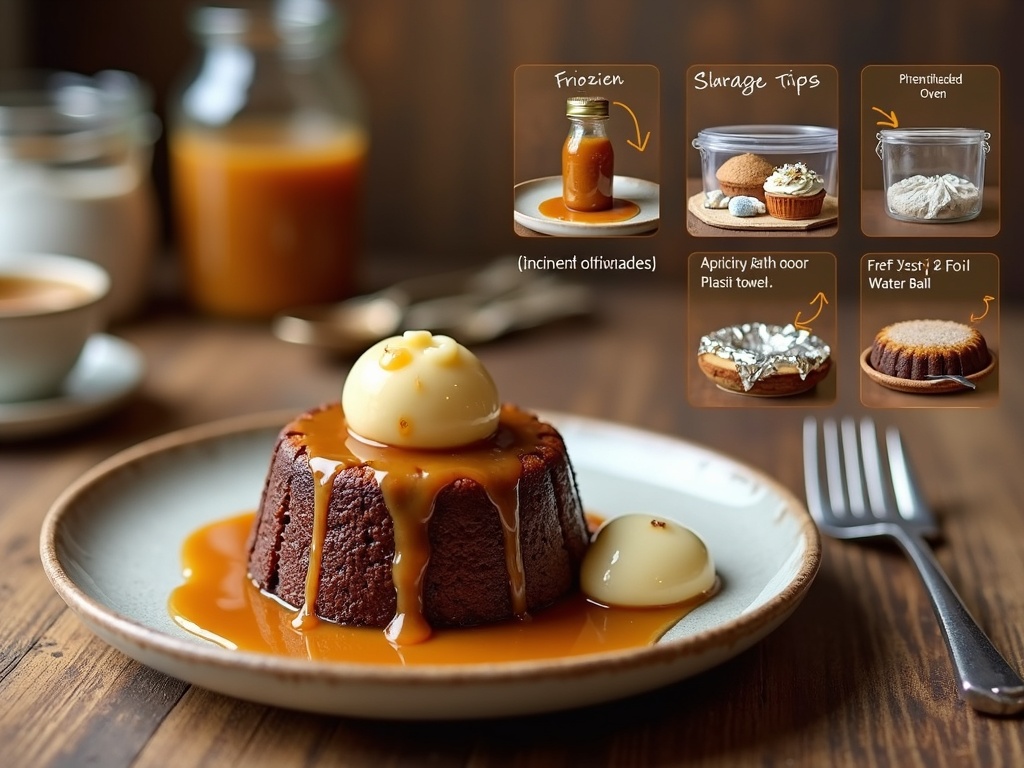
Storing Your Sticky Toffee Pudding Recipe
If you’ve got leftover pudding, don’t worry about it going to waste. To store baked sticky toffee pudding, simply cover it tightly with plastic wrap or transfer it to an airtight container. Stored in the refrigerator, the pudding will keep well for up to 5 days. The toffee sauce should be stored separately in its own airtight container in the fridge, where it’ll remain good for up to a week.
For make-ahead convenience, I recommend these approaches:
- Prepare the pudding batter a day in advance and refrigerate it in a covered container
- Bake the pudding up to 2 days before serving and store it covered in the refrigerator
- Make the toffee sauce up to a week ahead and simply reheat when needed
- Assemble the entire dessert a few hours before serving, then gently reheat
For longer storage, freezing is an excellent option. To freeze sticky toffee pudding:
- Allow the pudding to cool completely after baking
- Wrap individual portions or the whole pudding tightly in plastic wrap
- Add a layer of aluminum foil for extra protection
- Label with the date and freeze for up to 3 months
The toffee sauce can also be frozen in a separate airtight container for the same duration. I find that storing puddings properly maintains their quality and extends their shelf life significantly.
Reheating Methods for Perfect Results
One of sticky toffee pudding’s best qualities is how well it reheats. I’ve tested several methods, and each produces slightly different results:
- Microwave method (quickest): Place an individual portion on a microwave-safe plate and heat for 30–45 seconds. If the pudding has sauce already on it, cover it with a paper towel to prevent splattering. This method is fast but can sometimes result in slightly uneven heating.
- Oven method (best flavor): Preheat your oven to 325°F (165°C), place the pudding in an oven-safe dish, cover with foil, and heat for about 15–20 minutes until warmed through. This method produces the most consistent results and helps restore that fresh-baked quality. If you’re reheating a whole pudding like you would with fruit crisps, increase the time to 25–30 minutes.
- Water bath method (moistest result): Place the pudding in a heatproof container, cover tightly with foil, and set in a larger pan filled with hot water that comes halfway up the sides of the container. Heat in a 325°F (165°C) oven for about 20 minutes. This gentle reheating method prevents the pudding from drying out.
For frozen pudding, I recommend thawing it overnight in the refrigerator before reheating using one of the methods above. In a pinch, you can reheat directly from frozen, but you’ll need to approximately double the heating time.
The toffee sauce can be reheated in a small saucepan over low heat, stirring occasionally until smooth and warm. Alternatively, microwave it in 20-second bursts, stirring between each until it reaches your desired consistency.
When serving previously stored sticky toffee pudding, I like to add a fresh drizzle of warm sauce and perhaps a dollop of cream or custard to revitalize the presentation. This impressive dessert can be just as delightful the second time around when stored and reheated properly.

